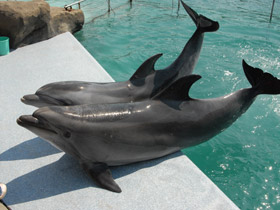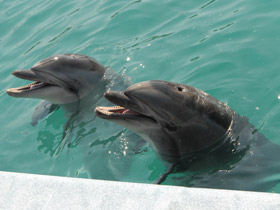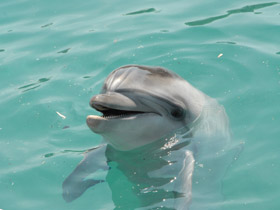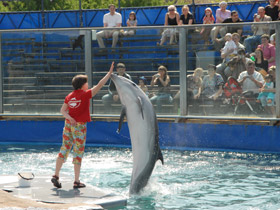The bottlenose dolphin Tursiops truncatus
Bottlenose dolphins are relatively sedentary; sometimes they migrate in small groups. Bottlenose dolphins live in a variety of habitats, from coastal waters to the open ocean. The dolphins that inhabit coastal habitats are adapted for warm, shallow waters. The dolphins living offshore are better suited to deep diving in cooler, deeper waters. While foraging bottlenose dolphins can dive to the depths of up to 90 metres in the Black Sea, and to the depth of up to 150 metres in the Mediterranean Sea. Bottlenose dolphins were reported to dive to the depths of 400-500 metres in the Gulf of Guinea. Under experimental conditions, one bottlenose dolphin dove to the depths of 600 to 700 m. Chasing their prey, bottlenose dolphins perform burst-and-glide swimming, and often make sharp turns. They stay under water from 6-7 to maximum 15 minutes. Most activity is observed in the daytime. Respiratory rates in the bottlenose dolphins are 1-4 breathes per minutes; their heart rates range between 80 and 140 beats a minute (average 100 beats per minute). The bottlenose dolphin is able to swim at a speed of 40 kph, and jump as high as 5 metres.
Bottlenose dolphins rely on sound for communication more than any other mode. Lacking vocal cords, they produce sounds using three pairs of air sacs located near their blowhole and connected with nasal passage. Studies suggest that a tissue complex in the nasal region may be responsible for all sound production. The frequencies of the sounds that a bottlenose dolphin uses for communication range from 0.2 to 50 kHz. Bottlenose dolphins produce whistles and sounds that resemble moans, trills, grunts, barking, squeaks, and clicks. Sounds vary in volume, wavelength, frequency, and pattern. When foraging and navigating underwater, the dolphins produce echolocation clicks with the frequency of 20-170 kHz, resembling the sounds of creaking doors. Apparently, signaling system is more sophisticated in older animals. The bottlenose dolphins undergo an unusual form of sleep called "slow-wave sleep." A dolphin shuts down only one hemisphere of its brain, and closes the opposite eye. During this time, the other half of the brain monitors the surroundings. Bottlenose dolphins sleep mostly in the night or in the day after feeding. Sometimes, dolphins hang motionless at the surface of the water during sleep, while other times, they may swim slowly. Bottlenose dolphins are distributed in temporal and tropical waters worldwide. In the Atlantic Ocean, bottlenose dolphins are found from Southern Greenland to Patagonia and from Norway to Uruguay, Argentina, and South Africa. They live in the Baltic, Mediterranean, Caribbean, and Black Seas, and in the Gulf of Mexico. In the Indian Ocean, they are found from the northern coasts of the Ocean to South Australia and South Africa. In the Pacific Ocean, bottlenose dolphins are found from northern Japan, Lesser Kuril Ridge, and Oregon to Tasmania, New Zeeland, and Argentina.
Gestation in the bottlenose dolphin female lasts 12 months. The calf is born underwater; it appears tail-first and immediately swims to the water surface to take its first breath of air. It is usually accompanied by its mother and two or three other females. In the beginning, the baby sucks milk every 10-30 minutes. Its mother turns on her side to help the young nursing. In the first two weeks, the calf stays close to its mother but later moves freely. The bottlenose dolphin young start eating solid food at the age of 3.5 to 6 months but they are not fully weaned until they are 18-23 months old. Bottlenose dolphins reach sexual maturity at the age of 5-6 years.















































